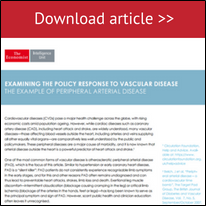While cardiac diseases such as coronary artery disease (CAD), including heart attack and stroke, are widely understood, many vascular diseases—those affecting blood vessels outside the heart, including arteries and veins supplying all other equally vital organs—are comparatively less well understood by the public and policymakers. These peripheral diseases are a major cause of morbidity, and it is now known that arterial disease outside the heart is a powerful predictor of heart attack and stroke.
Examining the policy response to vascular disease: The example of peripheral arterial disease
Health
Examining the policy response to vascular disease: The example of peripheral arterial disease
Martin Koehring is senior manager for sustainability, climate change and natural resources at Economist Impact (part of The Economist Group). He leads Economist Impact's sustainability-related policy and thought leadership projects in the EMEA region. He is also the head of the World Ocean Initiative, inspiring bold thinking, new partnerships and the most effective action to build a sustainable ocean economy.
He is a member of the Advisory Committee for the UN Environment Programme’s Global Environment Outlook for Business and is a faculty member in the Food & Sustainability Certificate Program provided by the European Institute for Innovation and Sustainability.
His previous roles at The Economist Group, where he has been since 2011, include managing editor, global health lead and Europe editor at The Economist Intelligence Unit.
He earned a bachelor of economic and social studies in international relations from Aberystwyth University and a master’s degree in diplomacy and international relations from the College of Europe.








